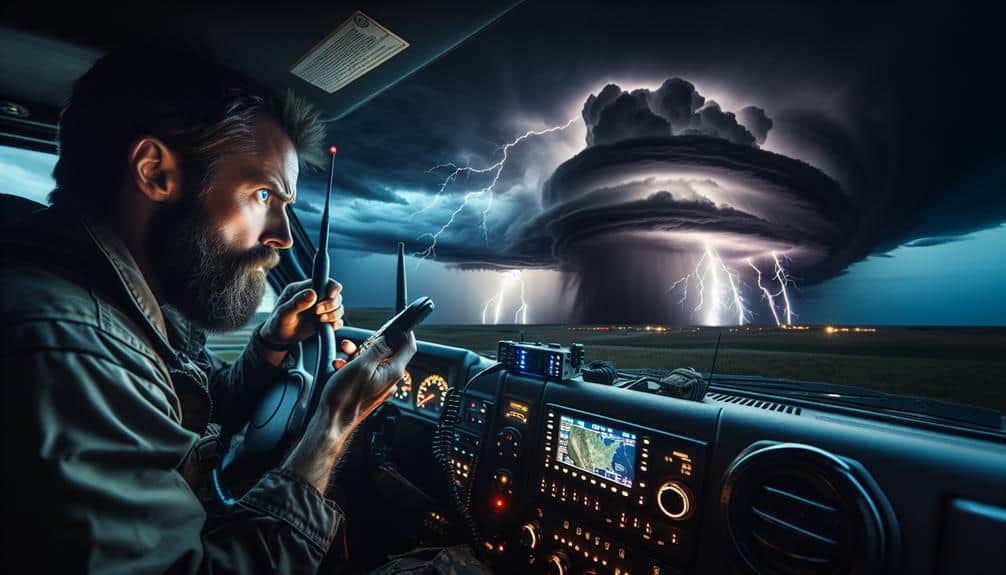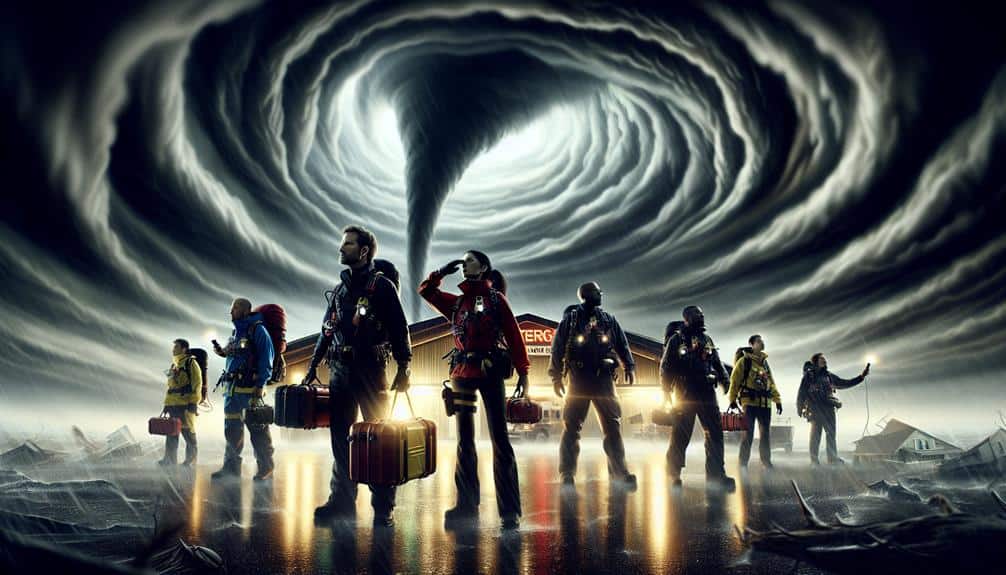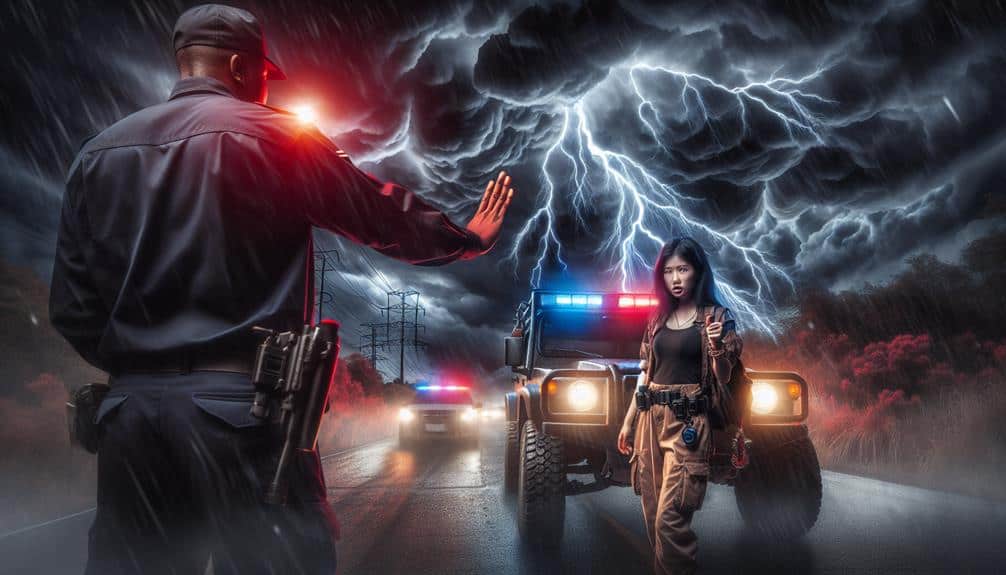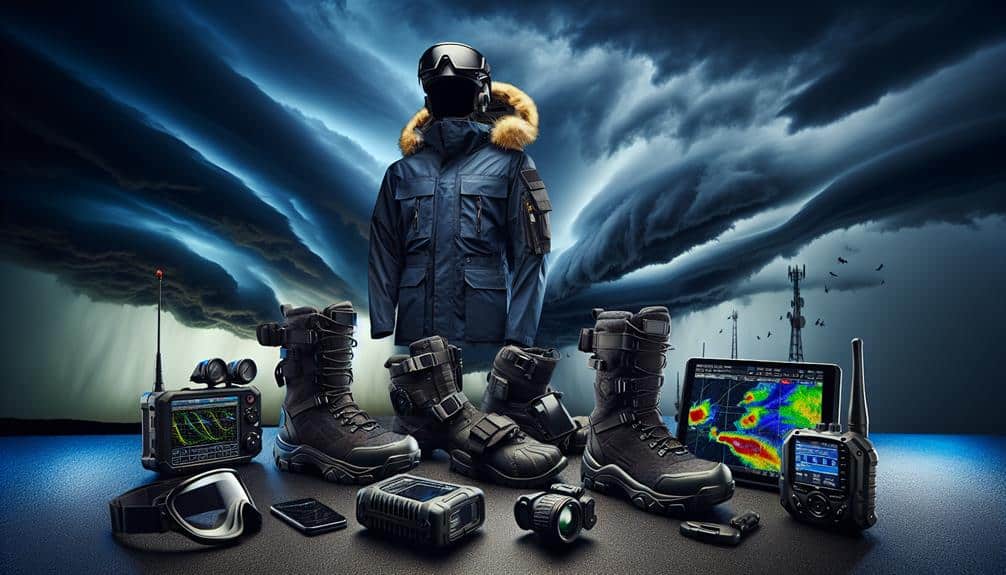As storm chasers, we prioritize safety by monitoring real-time weather updates and equipping ourselves with best gear. We use reliable vehicles with thorough maintenance checks and plan routes based on comprehensive risk assessments. Maintaining communication through GPS, two-way radios, and mobile apps ensures team coordination. We analyze storm patterns using Doppler radar and stay aware of immediate surroundings through continuous data feeds. Adhering to emergency procedures, respecting local authorities, and prioritizing personal safety, including locating shelters and packing safety supplies, are essential. Explore further into these practices to improve your storm chasing preparedness and safety.
Key Points
- Monitor real-time weather updates and use advanced radar technology for informed decision-making.
- Equip proper weather-resistant gear, including protective items like helmets and gloves, and maintain an emergency kit.
- Perform regular maintenance checks on reliable vehicles with safety features like anti-lock brakes and stability control.
- Plan routes using data-driven mapping tools and establish emergency response protocols for potential hazards.
Monitor Weather Updates
To secure our safety while storm chasing, it's critical we continuously monitor real-time weather updates using reliable meteorological sources. This ensures we make informed decisions based on the most current data.
Advanced radar technology provides high-resolution images that allow us to track storm developments with precision. By leveraging such tools, we can identify potential hazards early and navigate accordingly.
Weather tracking is essential, but it's equally important to have contingency plans. Knowing the locations of emergency shelters along our route can be lifesaving. We should always have clear evacuation plans ready, detailing the fastest and safest paths to these shelters. In high-risk scenarios, prompt evacuation is non-negotiable.
Data from radar technology isn't just about observing storm paths; it's about predicting changes. We keep an eye on wind speed, precipitation levels, and atmospheric pressure, which can all indicate shifts in storm behavior. This data-driven approach helps us maintain a safe distance from the storm's core while still conducting our observations.
Equip Proper Gear
While monitoring weather updates is essential, equipping ourselves with the right gear guarantees we can safely navigate and document storm environments. Our safety hinges on rigorous gear maintenance and regular safety checks. Ensuring our equipment is in prime condition minimizes the risk of gear failure during critical moments.
For instance, we should inspect our cameras, tripods, and communication devices before every chase, verifying battery levels and functionality. Proper attire is foundational to our protection. We need to wear layers that are both weather-resistant and breathable. Waterproof jackets, sturdy boots, and thermal underlayers are non-negotiable. Protective gear such as helmets and gloves can prevent injuries from debris or falls. High-visibility vests increase our visibility to other drivers and team members, reducing the risk of accidental collisions.
Additionally, carrying an emergency kit equipped with first aid supplies, flashlights, and multi-tools enhances our preparedness. A NOAA weather radio can provide real-time updates, ensuring we're always informed. By meticulously maintaining our gear and donning the appropriate attire, we can focus on the thrill of storm chasing while safeguarding our well-being.
Freedom in storm chasing comes with the responsibility of being well-prepared for all scenarios.
Use Reliable Vehicles
Selecting strong and dependable vehicles is crucial for safeguarding our safety and efficiency during storm chases. A robust vehicle not only withstands harsh weather conditions but also guarantees we can execute precise storm tracking. When choosing our transportation, we must prioritize vehicle maintenance and safety features. Regular maintenance checks are non-negotiable to prevent mechanical issues that could jeopardize our mission.
Incorporating vehicles with advanced safety features enhances our protection and operational capability. These features might include anti-lock brakes, stability control, and high-quality tires designed for various terrains. Reliable transportation is our lifeline; it provides the mobility and durability we need to navigate unpredictable storm paths.
To emphasize the importance of dependable vehicles, consider:
- Maintenance schedule adherence: Secures vehicle longevity and operational readiness.
- Safety features integration: Offers enhanced protection against extreme weather elements.
Choosing the right vehicle isn't just about getting from point A to point B; it's about securing we've the means to safely and efficiently carry out our storm-chasing endeavors. By prioritizing vehicle maintenance and equipping our rides with necessary safety features, we maximize our freedom to explore and document nature's most powerful phenomena.
Plan Your Route
When planning our route, we must map out potential hazards such as flood-prone areas and high-wind zones.
Utilizing GPS and physical maps guarantees we've backup navigation tools in case of technology failure.
Map Out Hazards
Mapping out potential hazards is crucial for storm chasers to guarantee safety and optimize the route for effective data collection. Before starting on our journey, we need to conduct a thorough risk assessment. This involves identifying possible dangers such as flash floods, falling debris, and downed power lines.
By understanding these risks, we can make informed decisions and strategically plan our route to avoid high-risk areas.
In our planning, we must also consider emergency response protocols. If we encounter unexpected hazards, having predefined actions can greatly reduce response times and potential harm. We'll need to:
- Identify nearest emergency services: Knowing the locations of hospitals and emergency shelters.
- Establish communication plans: Ensuring everyone in the team knows how to contact emergency services.
Data-driven mapping tools can provide real-time updates on weather conditions and potential hazards, allowing us to adapt our route dynamically. Incorporating these elements into our planning not only guarantees safety but also maximizes the efficiency of our data collection efforts.
To guarantee we don't lose our way during a storm chase, we must equip ourselves with reliable backup navigation tools. GPS devices are essential, offering real-time location data with precision. However, technology can fail, and that's why compasses serve as a vital low-tech alternative. Their magnetic reliability ensures we can always determine our cardinal directions, even when digital systems falter.
In addition to navigational tools, staying informed about weather conditions is important. Weather radios provide continuous updates on storm developments, giving us the data we need to adjust our route proactively. These radios operate independently of cellular networks, making them dependable even when other communication systems are compromised.
Satellite phones are another crucial asset. Unlike standard mobile phones, satellite phones maintain connectivity in remote areas, ensuring we can call for assistance if needed. This redundancy in our communication channels grants us the freedom to operate in less populated regions without losing contact with our team or emergency services.
Planning our route involves more than just knowing the way; it's about preparing for the unexpected. By integrating GPS devices, compasses, weather radios, and satellite phones into our toolkit, we enhance our ability to navigate safely and efficiently.
Maintain Communication

Effective communication is essential for storm chasers to guarantee real-time data sharing and coordinated safety measures. We need reliable methods to stay connected, making sure that everyone in our team is aware of the situation and can respond promptly to any changes.
Firstly, it's vital to have a well-defined communication plan. This includes:
- Emergency contacts: A list of essential contacts that we can reach out to in case of an emergency.
- GPS tracking: Utilizing GPS tracking to monitor each team member's location and make sure no one gets lost or left behind.
Adopting these strategies enables us to maintain situational awareness and act swiftly. To facilitate this, we use two-way radios, satellite phones, and mobile apps designed for storm chasers. These tools are invaluable in areas with limited cellular coverage, ensuring our communication remains uninterrupted.
Understand Storm Patterns
Understanding storm patterns is essential for accurately predicting storm behavior and ensuring the safety of our team. By integrating storm tracking and meteorology, we can analyze atmospheric conditions such as temperature gradients, humidity levels, and wind shear. These data points are critical for making informed decisions during our weather prediction processes.
First, we need to examine radar and satellite imagery to identify storm cells and their trajectories. This enables us to predict potential development zones for severe weather. Utilizing Doppler radar technology, we can measure wind velocities within storms, providing early indicators of tornado formation.
Next, we interpret numerical weather prediction models, which simulate atmospheric conditions based on current data inputs. These models help us forecast the intensity and movement of storms with greater accuracy. As storm chasers, we rely on this data to anticipate sudden changes in storm behavior and adjust our positioning accordingly.
Know Emergency Procedures

Armed with a well-rehearsed emergency plan, we can mitigate risks and guarantee our safety during unpredictable storm encounters. Our first step is to conduct regular practice drills. By simulating various emergency scenarios, we'll make certain that our response is swift and decisive. These drills should encompass:
- Evacuation routes
- Communication protocols
Having an organized approach allows us to react effectively under pressure, reducing the likelihood of injury or panic.
Equally vital is maintaining an updated list of emergency contacts. This list should include local emergency services, fellow storm chasers, and meteorological agencies. Quick access to these contacts ensures timely assistance and information, which is important during a rapidly evolving storm situation.
Moreover, always keep a disaster kit in our vehicle. This kit should contain first-aid supplies, non-perishable food, water, and any necessary medications. Regularly check and replenish the kit to maintain its readiness.
Incorporating these strategies into our routine not only enhances our preparedness but also guarantees we can continue our pursuit of freedom and adventure with minimized risk. Let's prioritize our safety by adhering to these scientifically-backed, data-driven practices.
Stay Aware of Surroundings
Remaining watchful and constantly monitoring our surroundings is essential for safely navigating through the complexities of storm chasing. By maintaining sharp environmental awareness, we can promptly identify potential dangers and make informed decisions.
Understanding weather conditions is paramount; utilizing real-time data from radar systems and satellite imagery assures we stay ahead of rapidly evolving scenarios.
We need to observe not only the sky but also the terrain around us. Flash floods, falling debris, and other hazards can emerge without warning. Implementing safety precautions such as pre-defined escape routes and reliable communication systems allows us to react swiftly to unforeseen events.
Moreover, our vehicles must be strategically positioned to avoid entrapment by deteriorating conditions. High winds and tornadoes can shift directions abruptly, and being cognizant of the storm's path is vital.
It's crucial to continuously update our situational awareness by cross-referencing multiple data sources and maintaining communication with fellow chasers.
In essence, storm chasing demands a combination of scientific rigor and instinctual responsiveness. By honing our environmental awareness and adhering to strict safety protocols, we maximize our freedom to explore while mitigating the inherent risks. Our watchfulness is our best defense against nature's unpredictability.
Respect Local Authorities

Coordinating our efforts with local authorities is essential to guarantee both our safety and the efficient management of emergency resources during storm chasing activities. By respecting their expertise, we enhance our operational effectiveness and minimize risks. Local authorities possess real-time data and situational awareness that can be crucial in making informed decisions.
To maximize safety and efficiency, we should:
- Follow instructions: Heed evacuation orders, road closures, and any directives issued by emergency personnel.
- Stay informed: Regularly check updates from local weather stations, emergency services, and government alerts.
When we follow instructions from local authorities, we align our actions with broader emergency management strategies. This guarantees that we're not inadvertently creating additional hazards or straining limited resources.
Staying informed through reliable sources allows us to make data-driven decisions, enhancing our ability to navigate volatile weather conditions safely.
Ultimately, our respect for local authorities underscores a commitment to both our safety and the community we're observing. By integrating their guidance into our storm chasing protocols, we uphold a standard of professionalism and responsibility that benefits all parties involved.
Prioritize Personal Safety
Ensuring our personal safety during storm chasing hinges on thorough preparation and adherence to established safety protocols. We must prioritize locating nearby emergency shelters before commencing our chase. This guarantees that we've a safe retreat if conditions deteriorate rapidly.
Our vehicles should be equipped with essential safety supplies, including first aid kits, water, and non-perishable food. These safety precautions aren't optional; they're essential to our personal health and survival in unpredictable environments.
Mental preparation is equally vital. Understanding the psychological stressors associated with severe weather conditions allows us to remain focused and make rational decisions under pressure. We should engage in regular mental exercises and stress-management techniques to fortify our mental resilience.
Data-driven approaches, such as using real-time meteorological data and advanced radar systems, enhance our situational awareness and decision-making capabilities. We must remain vigilant and adjust our strategies based on evolving weather patterns.
Frequently Asked Questions
What Should I Pack for Meals and Hydration During Storm Chasing?
We should focus on meal planning and hydration, packing high-energy snacks, water, and emergency supplies. Data shows that balanced meals and adequate hydration reduce fatigue and enhance performance, ensuring we're prepared for any situation.
How Can I Emotionally Prepare for the Intensity of Storm Chasing?
Facing the storm's fury, we need mental readiness like armor. Emotional support from our team is essential. Data shows pre-storm briefings and stress-management techniques greatly boost our resilience and readiness, ensuring we stay free and focused.
Are There Specific Apps Recommended for Storm Chasers?
For the Current Question, we recommend RadarScope and StormEye for precise tracking. These apps enhance our equipment recommendations and support robust communication strategies, ensuring we stay informed and connected while chasing storms, maximizing both safety and efficiency.
What Are the Best Practices for Documenting Storms Safely?
For documenting storms safely, we must use proper equipment like sturdy tripods and weatherproof cameras. We should monitor real-time weather updates to avoid dangerous situations, ensuring we capture valuable data without compromising our safety.
How Can I Find a Mentor or Join a Storm Chasing Group?
Finding mentorship opportunities and storm chasing groups is like maneuvering through a complex weather system. We should explore training programs and connect with experienced chasers through forums and social media platforms to gain precise, data-driven guidance.


